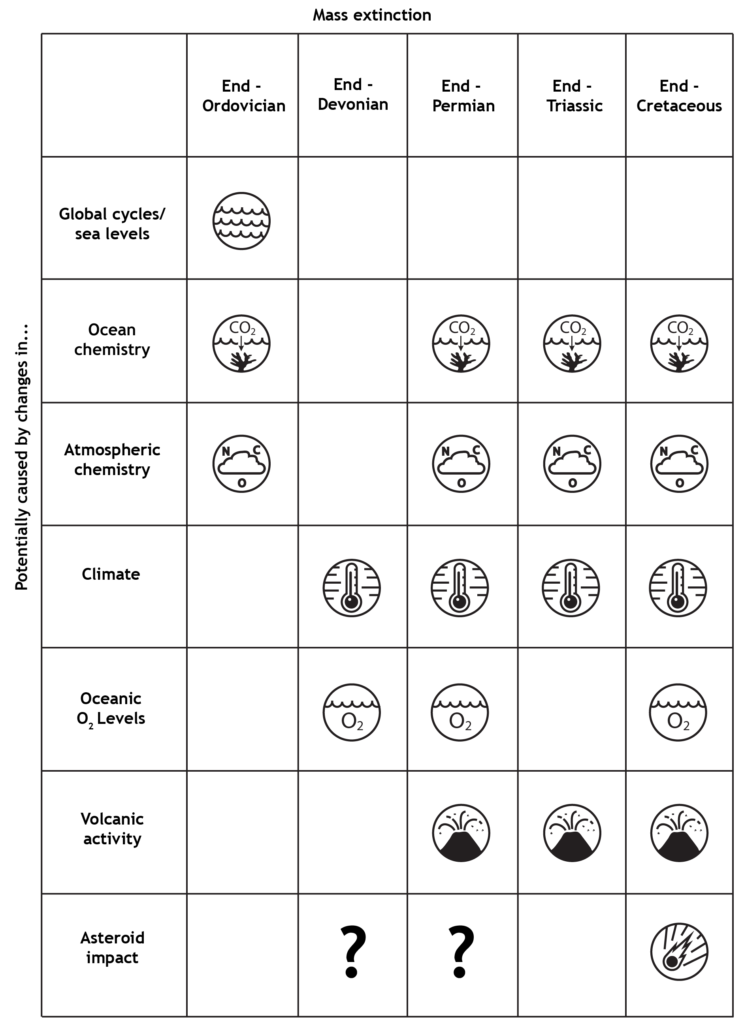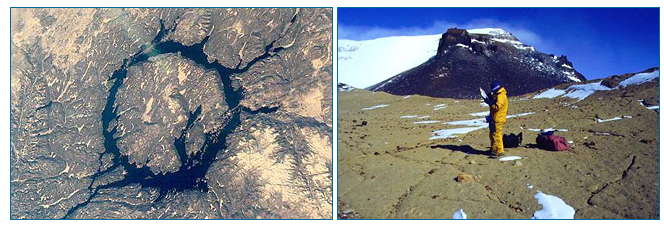Although the best-known cause of a mass extinction is the asteroid impact that killed off the non-avian dinosaurs, in fact, volcanic activity seems to have wreaked much more havoc on Earth’s biota. Volcanic activity is implicated in at least four mass extinctions, while an asteroid is a suspect in just one. And even in that case, it’s difficult to disentangle how much of the end-Cretaceous extinction was caused by the asteroid and how much was caused by the steady ooze of lava that was blanketing most of India at around the same time.
While multiple causes may have contributed to many mass extinctions, all the hypothesized causes have two things in common: they cause major changes in Earth systems — its ecology, atmosphere, surface, and waters — at rapid rates. Here are some hypothesized causes for each of Earth’s biggest mass extinctions:
End-Ordovician:
- Beginning of glacial cycles on Earth, and corresponding changes in sea level
- Changes in atmospheric and oceanic chemistry relating to the rise of the Appalachian mountains
End-Devonian extinction:
- Climate change, possibly linked to the diversification of land plants
- Decrease in oxygen levels in the deep ocean
End-Permian extinction:
- Volcanic activity
- Climate change
- Decrease in oxygen levels in the deep ocean
- Changes in atmospheric chemistry
- Changes oceanic chemistry and circulation
End-Triassic extinction:
- Volcanic activity
End-Cretaceous extinction:
- Asteroid impact
- Volcanic activity
- Climate change
- Changes in atmospheric and oceanic chemistry

What doesn’t cause mass extinctions?
It may not come as much surprise that powerful volcanic eruptions and massive asteroid impacts can trigger mass extinctions. After all, we’d expect such disasters to bring about death and destruction. However, as paleontologists and geologists have studied Earth’s history, they’ve noticed something interesting: sometimes, major catastrophes pass with hardly a blip in extinction rates. For example, the Manicouagan crater in Canada is several miles wide and constitutes strong evidence that a huge asteroid struck Earth one and a half million years ago — yet, the fossil record indicates no major dip in diversity associated with this event. Similarly, 2.5 km3 of lava (called the Karoo-Ferrar volcanic province) covering what is now South Africa and Antarctica indicate extensive volcanic activity around 180 million years ago — yet despite this large-scale disruption, only a small rise in extinction rates occurred during that time period.

Why do some catastrophic events trigger mass extinctions and others do not? The devil seems to be in the details — particularly in the chain reaction of Earth systems disruptions that are triggered (or not) and in the rate at which those disruptions occur. Mass extinctions seem to occur when multiple Earth systems are thrown off kilter and when these changes happen rapidly — more quickly than organisms evolve and ecological connections adjust. For example, the asteroid that triggered the end-Cretaceous extinction happened to hit carbon-rich rocks, which probably led to ocean acidification, and hence the disruption of reef formation and the oceanic food web. However, the asteroid that caused the Manicouagan did not hit carbon-rich rocks and so did not set off this chain reaction or such a significant disruption of Earth systems. The Karoo-Ferrar volcanic activity, on the other hand, was so large that it would certainly have disrupted Earth’s atmosphere and oceans; however, in this case, the changes came about very slowly. The volcanic activity was spread over millions of years. For comparison, the volcanic activity that may have caused the end-Triassic mass extinction likely occurred in less than 100,000 years, leaving no time for evolution to take place as habitats changed and leading to widespread extinction.
